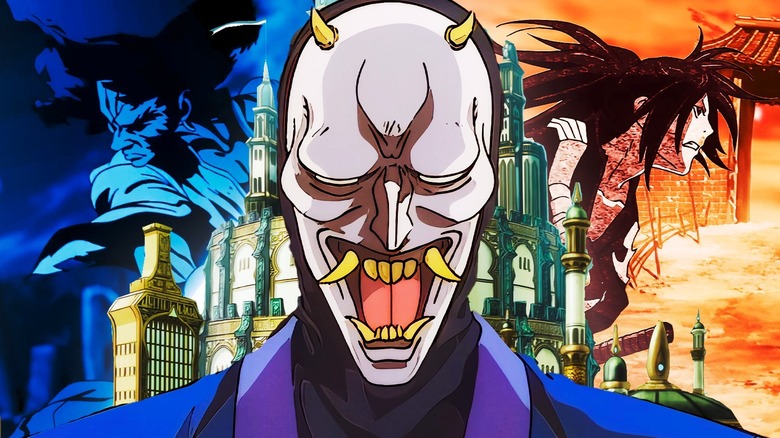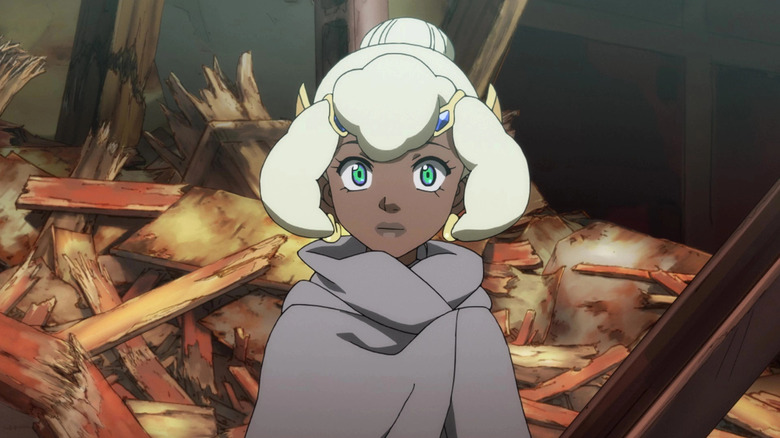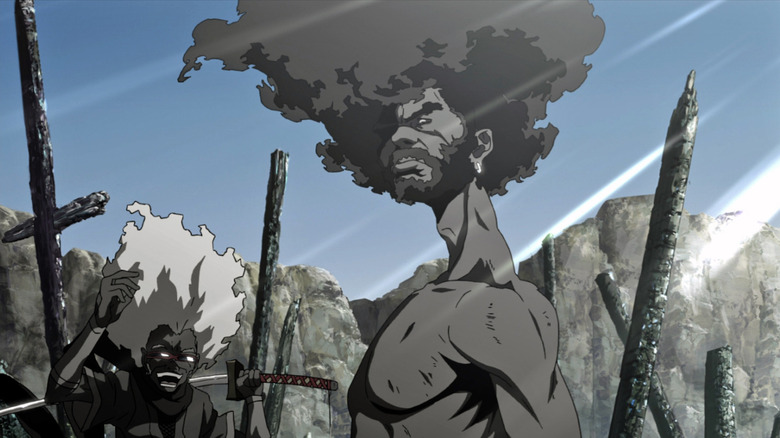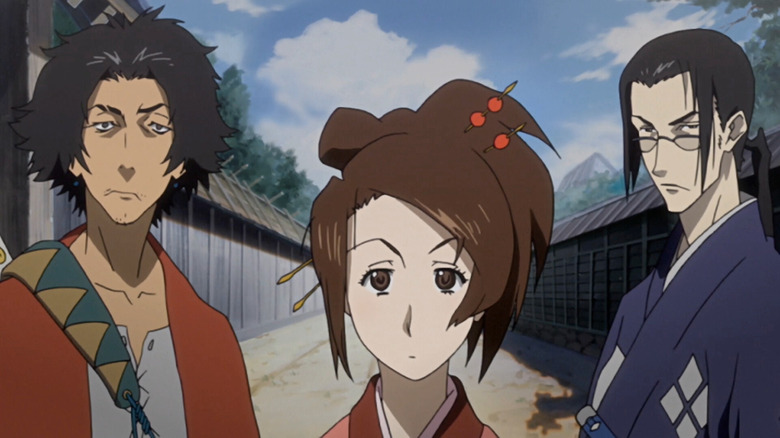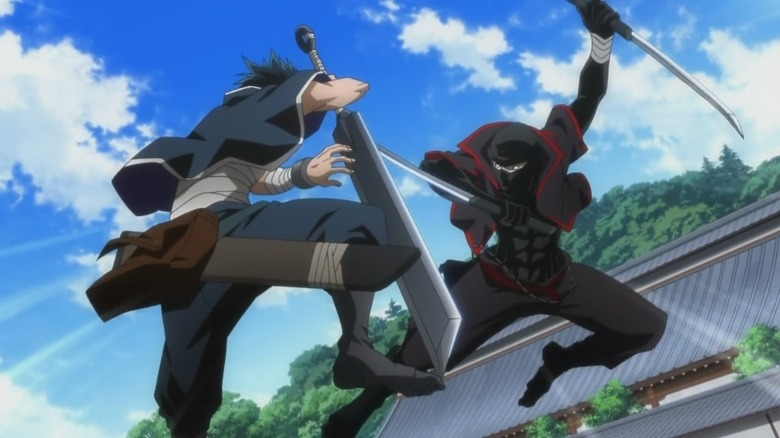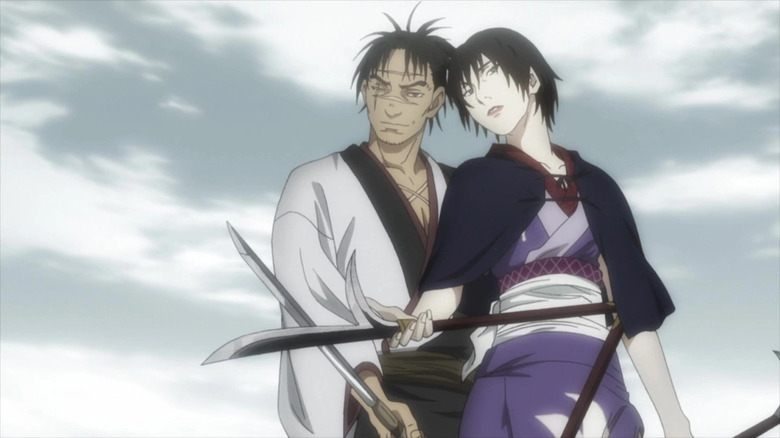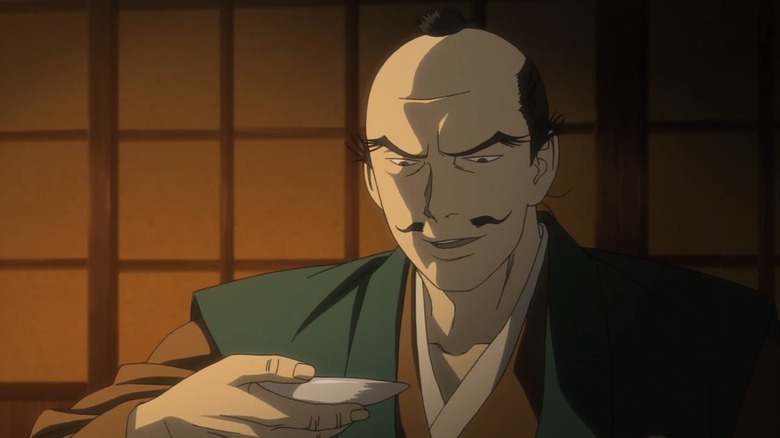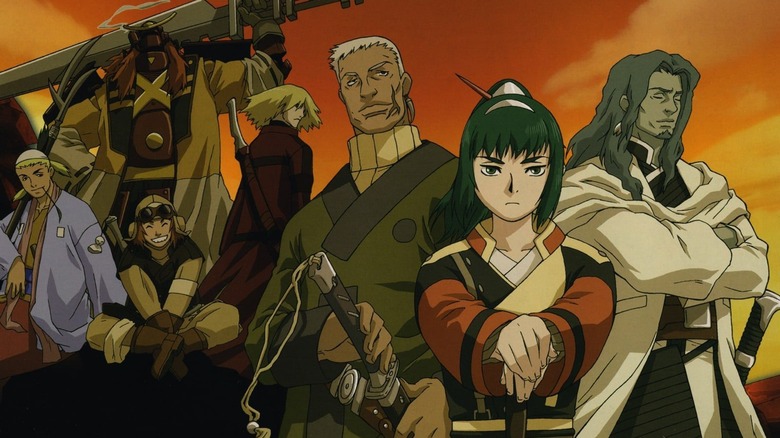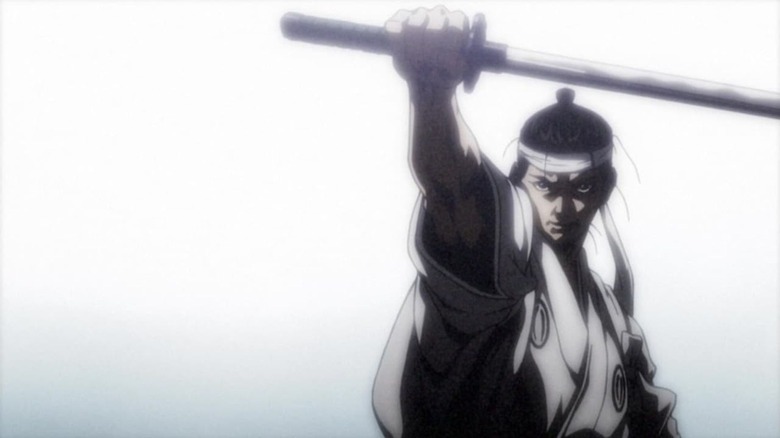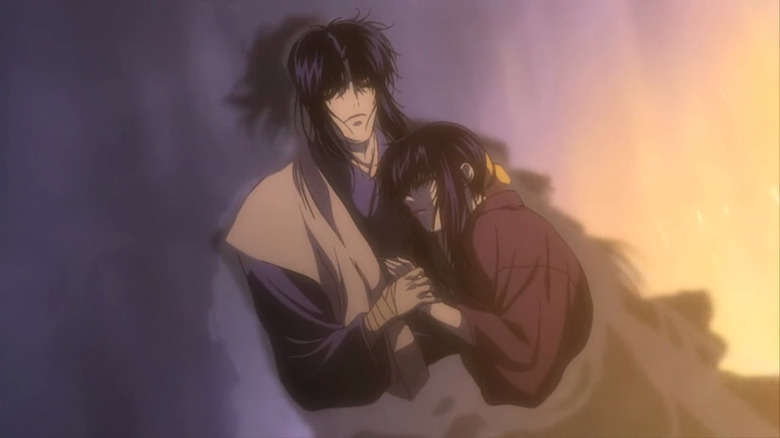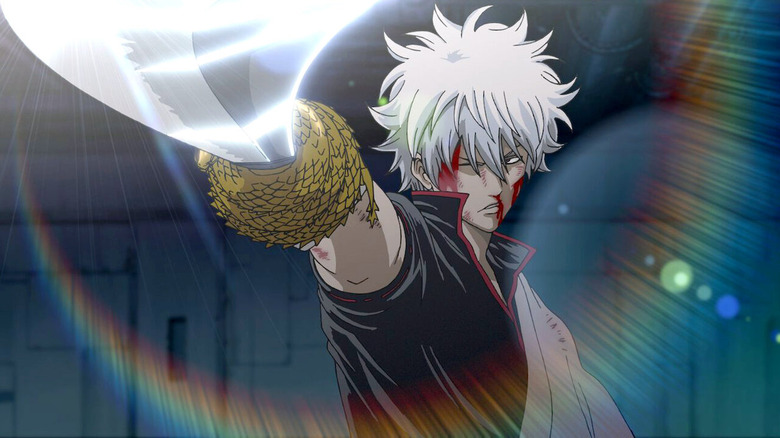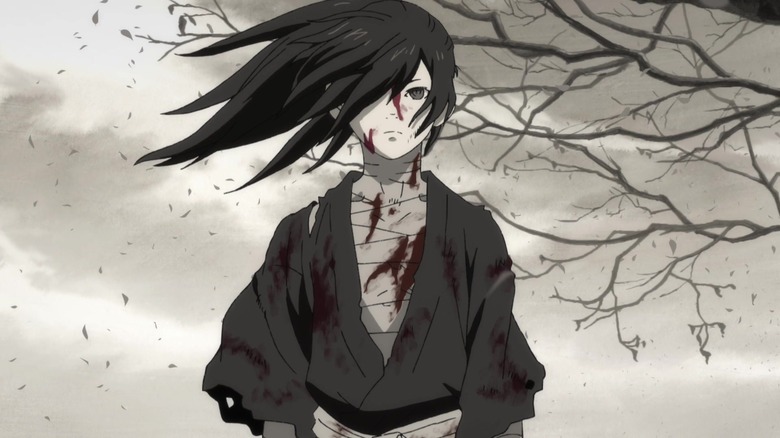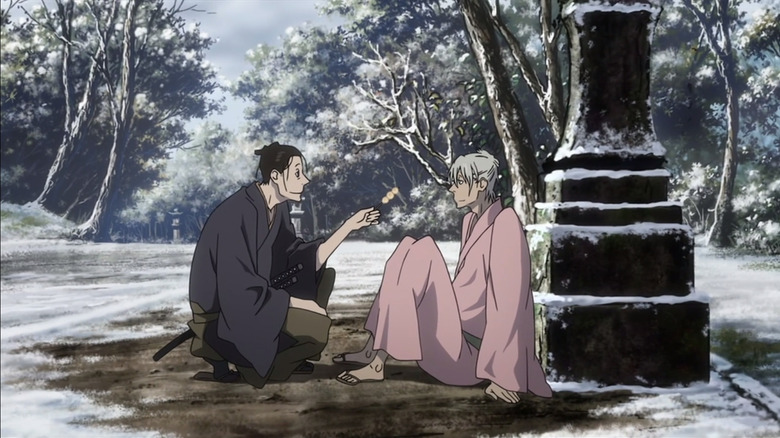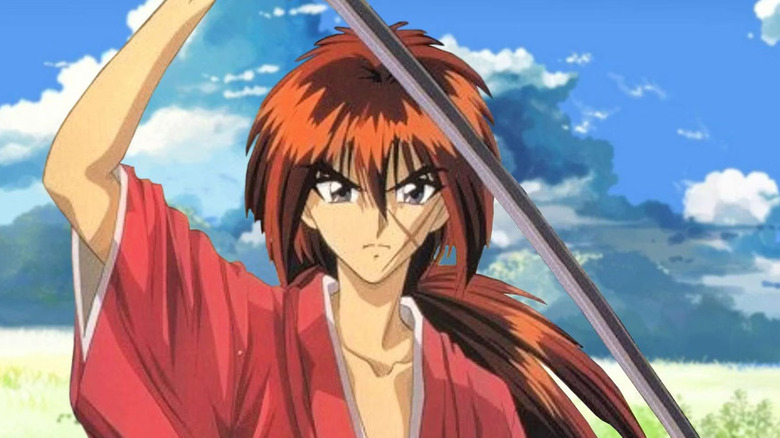Anime Shows You Should Watch If You Loved Yasuke
Released in 2021, "Yasuke" is an anime miniseries created by LeSean Thomas for Netflix. Based on a legendary figure from Japanese history, the titular Yasuke is an African man who comes to Japan with some Jesuit missionaries and eventually becomes a samurai in the service of Lord Oda Nobunaga. When Nobunaga and his forces are destroyed by another warlord, Yasuke flees and finds a quiet retirement as a boatman outside a small village. When he's asked to help a sick little girl get to a doctor, he soon finds himself called on to fight once again.
With only six episodes, it's entirely likely that "Yasuke" will leave you wanting more. Fortunately, there are lots of other anime series out there for you to watch, and quite a few of them have similar settings and themes. We've put together a list of anime you should check out once you've watched Yasuke, and most of them involve sword fights and Japanese history.
Cannon Busters
"Yasuke" isn't the only anime from creator LeSean Thomas to show up on Netflix, so if you're interested in his work, you should probably check out his first. "Cannon Busters" is about a robot girl named SAM who teams up with a criminal named Philly the Kid while looking for her best friend, Kelby, who happens to be the prince of their embattled kingdom. Nobody in "Cannon Busters" is quite what they seem at first. Philly is immortal due to an old deal with a devil, with a number appearing on his body for every would-be death. Meanwhile, SAM looks like an innocent young woman most of the time, but when one of her friends is in danger, she instantly converts to an intimidating "cannon buster" form.
"Cannon Busters" is LeSean Thomas's first real anime, although his previous adaptation of Aaron McGruder's "Boondocks" for Adult Swim certainly had anime influences. In "Cannon Busters," we begin to see the mix of Western and Japanese elements influencing his storytelling, whereas in "Yasuke," we see those elements fully come into harmony.
Afro Samurai
You probably don't need this article to tell you that if you're looking for another anime about a Black samurai, you should probably check out "Afro Samurai." But seriously, if you've never watched it, it's really good. Manga artist Takashi Okazaki was inspired by his love of hip-hop and soul music and decided to combine a Black protagonist and American storytelling elements with Japanese history and culture. The original legend of Yasuke is also said to be an inspiration for Afro Samurai, although that certainly wasn't Okazaki's focus. The manga was adapted into an anime miniseries in 2007, with a follow-up movie in 2009. Both feature the voice of Samuel L. Jackson and the music of the RZA.
Afro Samurai (yes, that's actually the character's name) lives in a futuristic feudal Japan that's even less interested in historical accuracy than the Mech-infused world of "Yasuke." Afro's father wore the Number One Headband, which grants power to the world's greatest warrior. When a gunslinger named Justice kills him and takes the headband, Afro devotes his life to becoming a great warrior so that he can one day exact his revenge and take the Number One Headband. Of course, he learns that vengeance is a complicated and messy path, but there are lots of awesome sword fights along the way.
Samurai Champloo
If you're looking for samurai stories infused with a modern hip-hop sensibility, you can't go wrong with "Samurai Champloo," which first aired in 2004. Acclaimed creator Shinichirō Watanabe's follow-up to his huge hit "Cowboy Bebop," this series replaces jazzy space battles with breakbeat sword fights to great effect. "Samurai Champloo" features two diametrically opposed fighters: the chaotic outlaw Mugen and the taciturn samurai Jin. Although they are enemies on sight, they reluctantly team up to help a young woman named Fuu on a mission to find a mysterious samurai from her past.
Although the series is set in a recognizable version of the Edo Period in Japanese history, it brings in modern music and sensibilities. Many of the episodes focus on figures who are outsiders in Edo-era Japan because of their nationality, race, or sexuality. In its way, the series becomes something of a statement about how diversity is not new but has been an element of many societies all along. Most importantly, however, even when it has things to say, "Samurai Champloo" never forgets to be a fun and engaging samurai adventure anime.
Brave 10
The 2012 series "Brave 10" takes place in the Sengoku period of Japanese history and retells the legend of the Sanada 10 Braves, a group of 10 ninjas gathered by the warlord Yukimura Sanada. The central character is Saizō Kirigakure, a ninja so skilled he's rumored to have never let an opponent touch so much as his hair. Saizō has killed many people and no longer seems to have much feeling about that (or anything in general) until he meets Isanami, a priestess he saves from a kidnapping attempt in the woods. They travel together to Yokimura's home, where Isanami seeks refuge, and Saizō joins the team he's gathering.
If "Brave 10" were a simple surface-level historical adventure, it would most likely be worth a watch. However, it has a bit more going on than just that. Each of the 10 Braves corresponds to an element, with Saizō representing light, something he has a hard time accepting about himself since he's caused so much death. Isanami, on the other hand, represents darkness, and when his power is unleashed, things become really interesting (and unfortunate) for all concerned.
Blade of the Immortal
"Blade of the Immortal" is another classic of samurai-focused anime. Originally a manga that began in the 1990s, the first anime version came out in 2008. There was a new anime in 2019, and both are worth a look if this is the sort of thing you're into, but we're focusing on the newer version. The immortal of the title is a ronin named Manji, who is unable to die because of some sacred bloodworms he got from a weird nun named Yaobikuni. It's clear at the beginning of the story that he's not fond of his immortality. For one thing, he's pretty sure it makes him a worse swordsman since he doesn't have to put in as much effort, and it gives him lots of time to dwell on the 100 good samurai he slew at the behest of his former master.
Manji makes a deal with Yaobikuni that she'll remove the bloodworms and allow him to die if he kills 1,000 bad men to make up for the 100 good men he killed. Meanwhile, a young woman named Rin Asano is looking for revenge on the warlord who killed her family. She reminds Manji of his late sister, so he's inclined to protect her, and of course, there are plenty of evil men to be slain along the way.
Hyouge Mono
Released in 2011, "Hyouge Mono" is based on the true story of a Sengoku-era warlord named Furuta Oribe. While the realm is torn apart by war and upheaval, Furuta becomes obsessed with the Japanese tradition of the tea ceremony. He's an aesthete by nature, taken with the simple beauty of things like tea, pottery, and architecture. In a time of constant war, his perspective is difficult for many to understand. Ultimately, Furuta Oribe becomes a legendary master of the tea ceremony. The anime shows the value of his perspective as well as the importance of aesthetic beauty and community-fostering traditions.
"Hyouge Mono" is an unusual story and an entertaining one. It also has a lot of perspectives to offer viewers, not just on Japanese history and traditions but on the value of the arts in the face of violence and conflict. That's certainly a theme with resonance for today's world.
Samurai 7
"Samurai 7" is an anime adaptation of the classic Akira Kurosawa film "Seven Samurai." It was released in 2004, 50 years after the original. Although it takes many departures from Kurosawa's version, starting with being set in the future, the seven warriors at its center have the same names and many of the same characteristics as their counterparts in that historical epic.
The wicked bandits that threaten a poor village in this version are cyborgs, making them that much more intimidating. A village priestess named Kirara is given the task of recruiting hungry samurai (since the town can only afford to pay them in rice), and the recruitment process is given a lot more space in the story, considering this is a 26-episode series as opposed to a movie. In addition to the grizzled leader Kanbei and the young romantic Katsushiro, the samurai include Kikuchiyo, an enormous armored cyborg with a truly huge sword. Perhaps inevitably, Katsushiro falls in love with Kirara, but Kirara falls for Kanbei, which inevitably leads to drama. And then, of course, they have to put all that drama aside to defend the village from evil cyborgs.
Shigurui: Death Frenzy
"Shigurui: Death Frenzy" came out in 2007, and the whole series revolves around one unusual fight. It's 1629, and the lord Tokugawa Tadanaga is holding a tournament in which the competitors will fight with real swords rather than the wooden training swords usually used for such activities. To the surprise of all in attendance, the first match of the tournament is between a one-armed swordsman named Fujiki Gennosuke and a blind Samurai named Irako Seigen. The series then goes on to tell the intertwined stories of these two men and how they came to this moment of inevitable conflict.
It turns out that Fujiki and Irako were both students of Kogan Iwamoto, a cruel sensei who runs his own school. Irako was once the heir to the school and engaged to marry Kogan's daughter, Mie. However, he also became involved with Kogan's concubine, Lady Iku, which led to his blinding and banishment. The less ambitious Fujiki then becomes Kogan's heir, despite losing his arm in an initial confrontation with Irako.
"Shigurui" is unrelentingly dark and grim in its tone, so it may not be for every viewer. The women characters are treated especially terribly, with depictions of sexual assault and extreme domestic violence. If you have a strong stomach, however, this is an entertaining and unflinching depiction of a dark time in Japanese history.
If you or anyone you know has been a victim of sexual assault, help is available. Visit the Rape, Abuse & Incest National Network website or contact RAINN's National Helpline at 1-800-656-HOPE (4673).
Basilisk: The Kouga Ninja Scrolls
"Basilisk: The Kouga Ninja Scrolls" was released in 2005 and takes place in the era when Japan was first united by one ruler, the Shogun Tokugawa Ieyasu. When Ieyasu first seizes power, the legendary ninja Hattori Hanzo ends a centuries-long feud between two clans, the Iga of Tsubagakure and the Kouga of Manjidani, by conscripting both to serve the new shogun. A few years later, in 1614, that peace ends when the two clans are ordered to each send their 10 best ninjas to fight to the death. It seems there's disagreement about which of Ieyasu's grandsons should eventually inherit the shogunate, and it's already threatening to tear the young nation apart. Each ninja clan will fight for one of the heirs, determining once and for all who will eventually rule Japan.
The ninja clans never asked for this, especially after they'd spent years putting their feud behind them. Gennosuke Kouga, leader of the Kouga clan, is a young man who strongly believes in looking to the future and not holding grudges. As proof of his principles (and because he's in love, of course), he's even engaged to Oboro, the heir to the Iga clan. Unfortunately, what the shogun says goes, and the two are bound to be mortal enemies.
Gintama
No anime mixes samurai and science fiction more enthusiastically than "Gintama" from 2006, a series that takes place in an alternate version of feudal Japan occupied by invading aliens. Although the samurai of this world defended Earth against the invaders, the shogun surrendered to the aliens and allowed their occupation. Twenty years later, technology has vastly increased, but publicly carrying swords is illegal, and samurai are persona non grata. That leaves Gintoki Sakata, the series' protagonist, to take up a life of odd jobs to make ends meet.
Despite his unglamorous new career, Gintoki employs Shinpachi Shimura, a teenage boy who wants to learn the way of the samurai, and Kagura, a friendly alien girl. Together, the three have adventures involving aliens and samurai as they struggle against the strange world they live in and Gintoki's shady past.
"Gintama" is extremely comedic in tone, with a lot of fourth-wall-breaking humor that pokes fun at manga and anime tropes. It might even be the silliest thing on this list, but after witnessing the violence and tragedy of shows like "Shigurui" and "Basilisk," something silly might be just what you need.
Dororo
The original "Dororo" anime was created by "Astro Boy" innovator Osamu Tezuka in 1968, but that's not the one we're here to talk about today. In 2019, Tezuka's original manga was adapted into a new series that brings modern sensibilities to the already unusual story. It tells of Hyakkimaru, a young ronin whose limbs and several organs were sacrificed to 12 demons by his father when he was a newborn. As an adult, Hyakkimaru is equipped with prosthetics and the ability to see (and, therefore, fight) demons hiding on Earth. On the road, he meets young Dororo, who becomes his traveling companion, as he looks to retrieve his lost body parts from the demons. Dororo not only helps him with day-to-day stuff because of his disability but also becomes his emotional tether to humanity, as he is tempted to give in to the violence that has defined his life. As you can tell from the premise, this one is extremely dark, but it's also emotionally rewarding.
Eventually, Hyakkimaru must confront his evil father and fight his younger brother, who has become his father's heir. It turns out Dororo has a complicated family history, as well, and needs Hyakkimaru's help at least as much as he needs hers. This dark fantasy goes to some pretty unique places with the "wandering ronin" premise, and the 2019 version is well worth a look.
House of Five Leaves
Another Edo period story, 2010's "House of Five Leaves" follows Masanosuke Akitsu, a down-on-his-luck samurai. Although he's a good swordsman, Masanosuke (or Masa for short) is a naturally timid man who gets uncomfortable around crowds. This leads to his shogun releasing him. Disgraced and unable to support his family, Masa moves alone to Edo (Japan's capital city, later renamed Tokyo). Looking for work as a bodyguard, he takes a job with a man named Yaichi, who turns out to be the leader of a criminal gang called the Five Leaves. Masa is initially reluctant to work with the Five Leaves, being more than a little uncomfortable using his skills for crime. However, he can't stop thinking about Yaichi's carefree attitude and gets increasingly drawn into the world of the Five Leaves.
Throughout the series, Masa tries to learn about Yaichi, whose origin story is finally told in the final episode. Yaichi was adopted by a prominent family but was kidnapped on his adoptive mother's instructions after she got pregnant with another son. He never goes back home, living the life of an outlaw from then on. Like Masa, he's a man who lost his family and is living the only life left to him, even if he seems to be having a great time.
Rurouni Kenshin
A classic of '90s anime, "Rurouni Kenshin" stands the test of time and is worth revisiting if you're in the mood for samurai stories (and if you've made it all the way through this list, you probably are). The title character is Himura Kenshin, a legendary assassin who has renounced his former ways and become a wandering swordsman who carries a "reverse blade sword," a katana with a cutting edge on the inner-curved side of the blade that makes it nearly impossible to kill with. As the series begins, Kenshin wanders into Tokyo, where he meets Kamiya Kaoru, a woman who owns a dojo. He takes up residence at the dojo, offering protection and help to those around him. Meanwhile, enemies from his violent past reemerge to cause trouble.
If you're looking for good anime about samurai and other sword-wielding Japanese historical figures, there's no shortage. This list probably could be twice as long, but we did our best to gather for you the cream of the crop from Champloo to Kenshin and focus on those that bring a modern sensibility to the table in a similar manner as "Yasuke."
